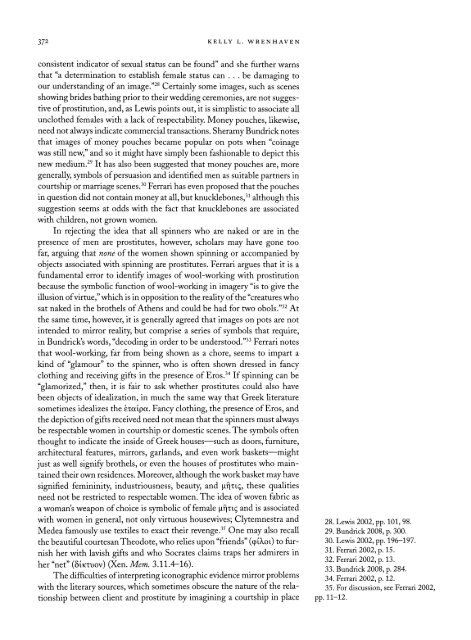Download - The American School of Classical Studies at Athens
Download - The American School of Classical Studies at Athens
Download - The American School of Classical Studies at Athens
You also want an ePaper? Increase the reach of your titles
YUMPU automatically turns print PDFs into web optimized ePapers that Google loves.
372 KELLY L. WRENHAVEN<br />
consistent indic<strong>at</strong>or <strong>of</strong> sexual st<strong>at</strong>us can be found" and she further warns<br />
th<strong>at</strong> "a determin<strong>at</strong>ion to establish female st<strong>at</strong>us can ... be damaging to<br />
our understanding <strong>of</strong> an image."28 Certainly some images, such as scenes<br />
showing brides b<strong>at</strong>hing prior to their wedding ceremonies, are not sugges<br />
tive <strong>of</strong> prostitution, and, as Lewis points out, it is simplistic to associ<strong>at</strong>e all<br />
unclothed females with a lack <strong>of</strong> respectability. Money pouches, likewise,<br />
need not always indic<strong>at</strong>e commercial transactions. Sheramy Bundrick notes<br />
th<strong>at</strong> images <strong>of</strong> money pouches became popular on pots when "coinage<br />
was still new," and so it might have simply been fashionable to depict this<br />
new medium.29 It has also been suggested th<strong>at</strong> money pouches are, more<br />
generally, symbols <strong>of</strong> persuasion and identified men as suitable partners in<br />
courtship or marriage scenes.30 Ferrari has even proposed th<strong>at</strong> the pouches<br />
in question did not contain money <strong>at</strong> all, but knucklebones,31 although this<br />
seems<br />
suggestion<br />
<strong>at</strong> odds with the fact th<strong>at</strong> knucklebones are associ<strong>at</strong>ed<br />
with children, not<br />
grown<br />
women.<br />
In rejecting the idea th<strong>at</strong> all spinners who are naked or are in the<br />
presence <strong>of</strong> men are prostitutes, however, scholars may have gone too<br />
far, arguing th<strong>at</strong> none <strong>of</strong> the women shown spinning or accompanied by<br />
objects associ<strong>at</strong>ed with spinning are prostitutes. Ferrari argues th<strong>at</strong> it is a<br />
fundamental error to<br />
identify images<br />
<strong>of</strong><br />
wool-working<br />
with<br />
prostitution<br />
because the<br />
symbolic<br />
function <strong>of</strong><br />
wool-working<br />
in<br />
imagery "is to<br />
give the<br />
illusion <strong>of</strong> virtue," which is in<br />
opposition<br />
to the<br />
reality<br />
<strong>of</strong> the "cre<strong>at</strong>ures who<br />
s<strong>at</strong> naked in the brothels <strong>of</strong> <strong>Athens</strong> and could be had for two obols."32 At<br />
the same time, however, it is generally agreed th<strong>at</strong> images on pots are not<br />
intended to mirror<br />
reality,<br />
but a<br />
comprise<br />
series <strong>of</strong><br />
symbols<br />
th<strong>at</strong><br />
require,<br />
in Bundrick's words, "decoding<br />
in order to be understood."33 Ferrari notes<br />
th<strong>at</strong><br />
wool-working,<br />
far from<br />
being<br />
shown as a chore, seems to a<br />
impart<br />
kind <strong>of</strong><br />
"glamour"<br />
to the<br />
spinner,<br />
who is <strong>of</strong>ten shown dressed in<br />
fancy<br />
clothing and receiving gifts in the presence <strong>of</strong> Eros.34 If can<br />
spinning<br />
be<br />
"glamorized," then, it is fair to ask whether prostitutes<br />
could also have<br />
been<br />
objects<br />
<strong>of</strong> idealiz<strong>at</strong>ion, in much the same way th<strong>at</strong> Greek liter<strong>at</strong>ure<br />
sometimes idealizes the exoupoc. Fancy clothing, the presence <strong>of</strong> Eros, and<br />
the depiction <strong>of</strong> gifts received need not mean th<strong>at</strong> the spinners must always<br />
be respectable women in courtship or domestic scenes. <strong>The</strong> symbols <strong>of</strong>ten<br />
thought to indic<strong>at</strong>e the inside <strong>of</strong> Greek houses?such as doors, furniture,<br />
architectural fe<strong>at</strong>ures, mirrors, garlands, and even work baskets?might<br />
just as well signify brothels, or even the houses <strong>of</strong> prostitutes<br />
who main<br />
tained their own residences. Moreover, although the work basket may have<br />
signified femininity, industriousness, beauty, and uf|Ti(;, these qualities<br />
need not be restricted to respectable women. <strong>The</strong> idea <strong>of</strong> woven fabric as<br />
a woman's weapon <strong>of</strong> choice is<br />
symbolic<br />
<strong>of</strong> female \ir\xi
















